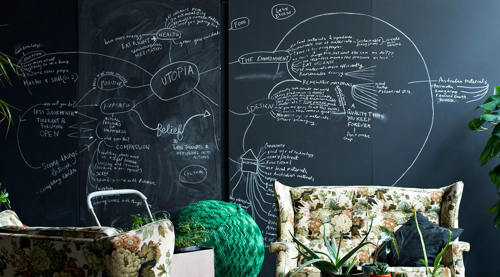Mind Maps are Bad
Delia Neely, 2023/05/19
When I was giving my PDF library some rightful spring cleaning, I stumbled upon a very peculiar book about 2010s interior design. The first thing I asked when skimming was "Why do all of the cities displayed not only have a grocery store within walking distance, but also a fucking Guggenheim?" and the second thing I asked was "Wait... Just what the hell is on that chalkboard?"
A prominent feature of this book are the photos of interviewees' interiors. A prominent photo within this feature however, is a chalkboard in a comically bare loft. It's featured not only in its respective page, but also the inner title page and the table of contents. It begs to be the first impression.
So, what is this chalkboard? Why should it take up so much attention?
I am not amused.
In previous iterations of this passage, there was a lot of yelling with very few actual words, and that's unhelpful. Instead of an object of venom, this screed can be a good jumping off point to look into the objects of venom we tolerate every day. We just have to look at what we've gotten all too used to.
Let's start at the obvious. What is being said here? Well, it's a rich couple's set of goals. A vision of one's ideal future, condensed into a hundred chunks of three word platitudes and strewn about on a wall. It's frankly tragic.
This is what you get when using mind maps! You get a hundred small platitudes strewn about. Walls of fragments telling you to eat your greens.
A good place to start on why this happens is to ask "Why does this need a hierarchy?" Typically a mind map starts with the overarching topic be front and center, followed by the five or so subtopics. This sucks! Why would you devote nearly half of your workspace to defining the topics with bounding circles and ornamental drawings, instead of leaving them to the corners, as reference?
Hell, even putting ideas with similar neighbour discourages unconventional connection. When you connect two things across a map, you have to draw a line that not only adds visual noise, but shuts away other connections by building boundaries with lines.
Merging connections are discouraged in a tree-based system, as trees don't usually join their branches, especially if branches are clear across themselves.
Organization, inherently, means that rules are applied to the information it organizes. Mind maps inflict hierarchy onto the information and later state, through difficulty of revision, that the information is inherently hierarchical. Using mind maps, your first draft is law. Brittle, unfitting, ever-present law.
We tend to approach computing as a scale model of reality, where programs are replications of things that existed before it. Calculating, recordkeeping, games, whatever. But a computer isn't just a calculator, just a notebook, or just a gameboard. A computer, most of the time, receives and processes an input into an output. That's so broad it's criminal.
The rules that have been placed onto computing, that it has to reflect real life, that it has to reflect the boundaries of paper, is at best a collective misdemeanor against humanity.
A computer, with enough time and with enough sensors, can gift any input an output. It's a platform of free associations. Treating the guidelines that made research easier decades ago as immutable law is now stopping research.
Do I have any suggestions? Well, I'd say a good stepping stone is to not just give people tools that are easily accessible, like office supplies, but also give people the means to build mechanical devices. Make sensors as broad and as plentiful as LEDs, and build a broad guide of what can be done.
The core of why computing is in this period of stagnation, this period of imbalance where objectivist capitalists are running the field of possibilities into the ground, is because they have full mastery of a field solely because they were given enough time to learn a language. In the field's current state, programming is only for programmers. But states can change.
